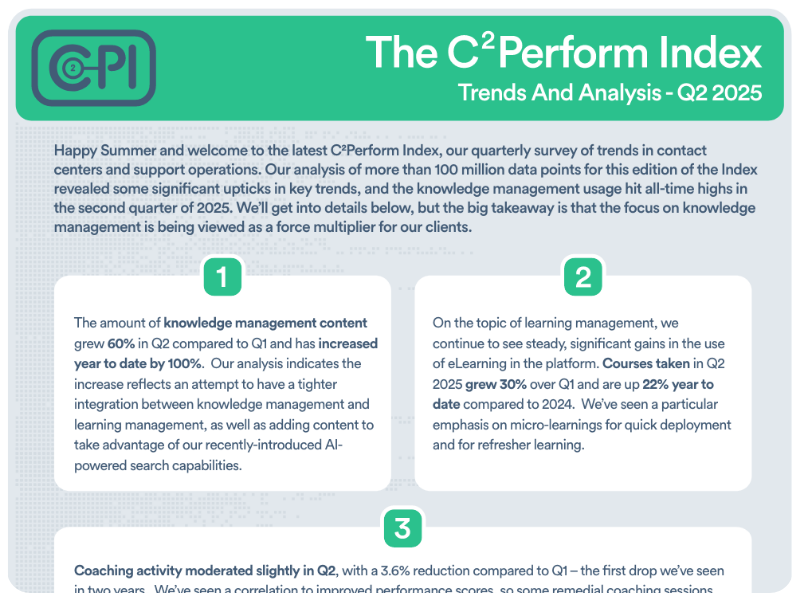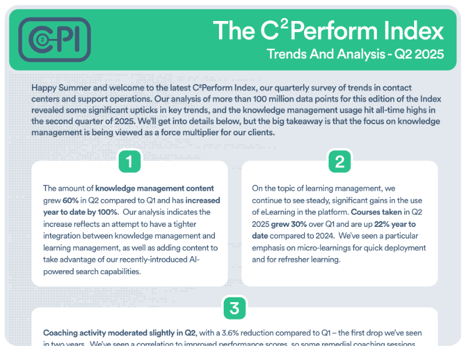Discretionary effort is the often untapped potential within your team, the extra mile they can choose to walk when they're truly engaged. It's what happens when people care enough to contribute beyond their job description, when they raise their hand before being asked, and when they take action.
In customer support operations, it's what elevates service from functional to exceptional. That often means the difference between good and great in the customer’s experience, your performance metrics and profitability.
While this may make discretionary effort sound like magic, it is a real concept that you can encourage and cultivate in your team, though it will require some effort. And how do you encourage it in a way that feels authentic and sustainable, not forced or performative?
How does discretionary effort add up over time to equal success for your team? Most importantly, what can you do to encourage contact center staff or customer support employees to go that extra mile?
Let's explore what powers this invaluable asset and how you can cultivate it. This guide will help you understand discretionary effort and explore actionable ways to nurture it, backed by industry insight.
What Is Discretionary Effort?
Discretionary effort is the term for the level of work or commitment that an employee could give that goes above and beyond the minimum level of effort necessary for their job function. It’s when employees are engaged with their work and willing to be engaged and committed enough to go beyond the bare minimum job requirements.
Employees with the highest amount of discretionary effort are often the most valuable resources in your organization.
What Discretionary Effort Looks Like
Discretionary effort isn’t just about working longer hours. It shows up in moments that are hard to measure but easy to feel:
-
Solving a customer issue proactively rather than passing it along
-
Volunteering to mentor a new teammate
-
Giving feedback on processes with the goal of improving them
-
Participating in training—not for a requirement, but out of genuine interest
-
Going above the minimum in tone, empathy, or accuracy in customer interactions
These behaviors aren’t rare—they just need the right culture to surface consistently.

Fostering a culture of discretionary effort is essential for cultivating a high-performing contact center team. When employees go above and beyond, they exhibit a range of behaviors beyond simply working harder or longer. Through conversations with C2Perform clients, we've discovered various ways teams demonstrate discretionary effort, including:
- Taking a proactive approach to solving customer issues
- Eagerly engaging in learning programs and sharpening their skills
- Identifying ways to improve efficiency, often through process changes
- Mentoring new colleagues without being asked to improve performance across the team
- Working overtime when necessary
- Providing positive feedback and suggestions to help improve the work environment
The Difference Made by Discretionary Effort
You may well be facing a situation today where some of your employees show up, do what’s expected of them and go home. Absolutely nothing wrong with that. In fact, you need those people to succeed.
But what if you could get more of your team to exhibit those discretionary efforts described earlier? What could that mean to your contact center? When discretionary effort is present, you’ll see real impact:
- Achieve higher customer satisfaction scores.
- 10% increase in customer metrics and a 20% increase in sales.
- Higher discretionary effort often leads to lower turnover rates.
- Gartner suggests encouraging discretionary effort experience 57% lower employee turnover.
- Process customer queries more efficiently and effectively, leading to higher productivity rates.
How to Encourage Discretionary Effort
How can you transform your team members who currently lack discretionary effort into invaluable assets dedicated to propelling your organization's long-term success? The key lies in motivating them to consistently exceed expectations in every shift, customer interaction, and meeting.
Here are a few ideas to help you get started:
1: The Foundation lies in Prioritizing Employee Engagement
If employees aren’t enthusiastic about their work, then it’s really unlikely that they’ll go the extra mile to drive results. Driving employee engagement is crucial for getting your team to exercise discretionary effort and to keep making that effort. So, what are some ideas to engage contact center employees?
- Provide recognition for extraordinary effort and results. For example, if Rob was on your team and getting 3x the upsells of others, taking the time to congratulate him on that could help keep him motivated to stay the course. Some ideas for employee recognition programs include social media shout outs, company swag, or unexpected paid time off. You can use an engagement tool to gamify work and give out rewards, but you don’t have to. For more examples of the benefits of recognition programs, check out this blog.
- Be intentional about creating meaningful and productive coaching sessions. There are lot of ways to improve coaching sessions, but a powerful one is to start every session on a positive note. When guiding a one-on-one session, try to start with a positive comment first. We tend to be very good at focusing on behavior we want to change instead of recognizing what someone is doing well. No wonder that only 26% of employees surveyed by Gallup said that feedback they received helped them do better work.
Another great way to make coaching session more effective is to use a coaching platform make sure coaching aligns to the key performance outcomes. When coaching doesn’t align with key performance outcomes employees can feel as if it is a waste of their time and can feel unengaged.
- Connect work with purpose. Employees need to know that their work matters and why it matters to remain engaged in the long term. As noted by Forbes, “Engaged employees are doing meaningful work and have a clear understanding of how they contribute to the company’s mission, purpose and strategic objectives.” When your team knows why their work matters and how it impacts others, they’ll have an easier time staying motivated and exercising that discretionary effort that will help everyone meet their goals.
These are just a few basic ideas to help improve employee engagement to encourage discretionary effort. For more engagement ideas, check out this blog.
2: Collect and Act on Employee Feedback
A big part of getting employees to take initiative and do more is giving them a feeling of empowerment that their opinions matter. An easy way to do this is to actively ask for—and then act on—employee feedback about the workplace.
For example, say that, during a meeting, one of your team members says that a lot of the customers they talk to are expressing frustration with the automated voice system or bots the company uses to route incoming calls or try to resolve simple issues.
You could use that feedback as the basis for making changes to that system that either eliminates redundant steps, improves the rate at which customers are connected to the right resource, or even change solutions entirely to improve functionality.
By acting on this kind of feedback, you can keep your team encouraged to provide such insight again in the future. They feel like they have a voice. Congratulate them on how the feedback helped improve the customer experience—encouraging others to provide more feedback as they identify similar issues.
How you collect employee feedback and the questions you ask are important as well. Many organizations don’t properly record their employee feedback so it can’t be acted on because they're dependent on manual processes and systems to collect feedback.
Without a proper communications platform, aren’t in place so that feedback can be recorded. Make sure your organization has the proper tools to ensure that communicating with employees and collecting feedback is done right. Whether these are manual or automated, they’re critical.
3: Rethink Your Onboarding Process
Do your new hires know what the most important metrics in your contact center are? What about their job expectations, how the tools they’re supposed to use work, and the company’s mission? How about what they can expect in the way of support during the critical onboarding period.
Zippia published some great research (actually some of the best we've seen) about onboarding and its impact on a company. Highlights included:
- Organizations with strong onboarding processes increase new hire retention by 82% and improve productivity by 70%.
- 88% of employees believe that their company doesn’t do a great job when it comes to onboarding new employees.
- One-third of approximately 1,000 survey respondents said they had quit a job within six months of starting it.
How you are onboarding new employees directly affects retention and how motivated and engaged employees will be. It’s time to quit thinking about onboarding as forms to be completed and new hire training and nesting and look at it as a journey for your new employees.
Every touchpoint should be mapped out, shared with the employee and everyone involved in the journey and measured to make sure each step of the journey happens. Think beyond the norm and include surveys, learning reinforcement, structured coaching, focused QA, recognition and skills development as part of the onboarding journey.
Being able to track and make sure all employees have gone through their training makes sure you will have well-qualified and more motivated call center employees.
A learning management system can also organize and consolidate your training resources in one place so that important training content isn’t in the onboarding process. (Ours even lets you create those onboarding journeys, but you can do it manually as well if resources are an issue.)
Either way, optimizing the onboarding process for contact center employees – and looking at it in a different light – will directly affect whether or not new hires will contribute discretionary effort. Even new hires with the highest potential can become unmotivated if onboarding is not executed correctly.
4: Creating Advancement Opportunities
“Where do you see yourself in five years?”
Okay, who are we kidding? Five years? How about two?
It’s a pretty standard interview question. One that asks the employee to consider their career path with your organization. However, it isn’t just the interviewers that ask the employees this question—eventually, the employee will start to ask where their career is going and where they want to be. So how are you creating an employee development plan and making sure your call center employees feel like they have a real career path with measurable objectives?
If an employee doesn’t see any opportunity for advancement, then they aren’t likely to put in the extra work needed to stand out.
Lack of career development opportunities in contact centers and customer support operations can lead to lowered morale and engagement among employees, who may feel undervalued and disconnected, resulting in decreased productivity. Naturally, discretionary effort is unlikely to happen too.
However, you introduce a new mentorship program—one where more experienced or higher-performing team members start advising new hires with an eventual goal to raise someone to a permanent trainer position or to be a new team lead. On hearing about this opportunity, you will likely see some of your team members working with more purpose to qualify for the program as a mentor—spending more time on each customer interaction and dedicating some time for learning new skills. That employee’s metrics improve and, when they start mentoring a new team member, the new hire produces satisfactory results in a shorter timeframe than is typical for your organization before the program.
Implementing a career development program for potential future frontline leaders can produce discretionary effort, better employee engagement and a reduction in turnover by offering a clear path to advance. This not only prepares an employee with essential leadership skills but also boosts team productivity and morale and shows a commitment to employee growth. (Not to be overlooked, it also lowers recruitment expenses.)
Why C2Perform?
Discretionary effort is more than just behavior—it’s a culture. C2Perform was built to support the habits and systems that make that culture sustainable.
Our platform helps:
-
Create visibility with recognition feeds and performance insights
-
Streamline coaching that aligns with real KPIs
-
Connect learning, QA, and feedback in a unified workflow
-
Track onboarding and engagement at every stage
We’ve helped 100+ support teams worldwide elevate performance through meaningful engagement—not mandates.
Building a team that goes the proverbial extra mile is hard work, but using some of the tips in this blog can get you started. If you’d like to chat with us about best practices we’ve seen in working with 100+ brands around the world, book a discovery call. We’d be glad to help, and there’s never any obligation.
 English
English Español
Español






.png?height=350&name=Untitled%20(300%20x%20175%20px).png)



